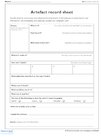Learning from artefacts
Add to My Folder
Surviving artefacts offer a fascinating glimpse of ordinary lives, raising questions and providing insights into the Indus society

‘The Indus people must have wanted their children to have nice childhoods.’ This is one Year 6 child’s conclusion after experimenting with a replica terracotta cart and examining photographs of cubed dice and terracotta figurines, some with moveable heads. These artefacts may not all have been toys, but his thoughtful comment implies the learning of other things about Indus society: that there was a good quality of life and that people 4000 years ago had the same emotions as we do today.
The climate and soil conditions in the Indus region have prevented perishable materials from surviving. Virtually all materials such as cloth, pigments and wood for furniture and construction have gone. All that remains of these are impressions of fine weave on other artefacts and thread fragments on metal tool handles. However, a vast range of non-perishable artefacts have been discovered and children can categorise these in various ways.
Scholastic Resource Bank: Primary - join today!
- Over 6,000 primary activities, lesson ideas and resources
- Perfect for anyone working with children from 5 to 11 years old
- Unlimited access from just £1.25 per month
Already a member? Sign in below.
Published 3 October 2007
Reviews
You need to be signed in to place a review.

